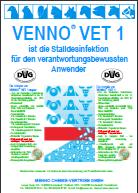Disinfection for the responsible user.
The effectiveness of VENNO® VET 1 super is warranted not only in the "warm" seasons but at low temperature as well.
Heating of barns/stables is quite expensive, considering the ever increasing energy costs. Besides, the ready-for use-solution will cool down the surfaces again, as the water used comes fresh from the well or tap at temperatures from 6 °C to 12 °C.
VENNO® VET 1 super is to be used at 1 % solution and contains (as concentrate) 55,0 % formic acid as active ingredient.
The decree regulating use of hazardous substances demands substitution of these substances with less hazardous ones, if possible. VENNO® VET 1 super fulfills this requirement. So, considering this, the aspects of effectiveness, potential hazard to the user and also tolerability towards materials and laws of liability towards the environment.
Leaflet with further information about DVG listing, effectiveness, material-tolerability and tolerability towards materials and lacquered surfaces.
Spectrum of effectiveness: By proper use VENNO VET 1 super is effective against bacteria, fungi and viruses (enveloped and unenveloped): as e.g. MRSA (methicillin-restistent Staphylococcos aureus), FMD (foot and mouth disease), classical swine fever, Influenza A (Bird Flue), porzines Circovirus Typ 2 (PCV 2), serpulina hyodysenteriae (diarrhoea), felines Calicivirus (FCV), paramyxyo virus, e-coli, ND (newcastle disease), aujesky’s disease, equines herpes virus, chlamydia, TRT (turkey rhinotracheitis virus), PRRS, african swine fever, BVD, IBR, tuberculosis, ornithobacterium rhinotracheale, salmonella, enterococcus, staphylococcus, canine morbilli virus, etc.


